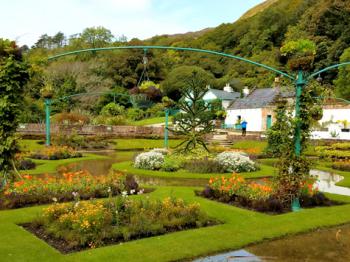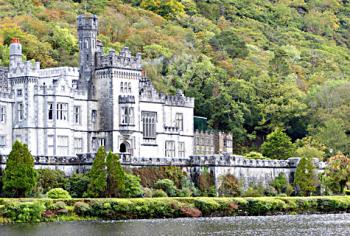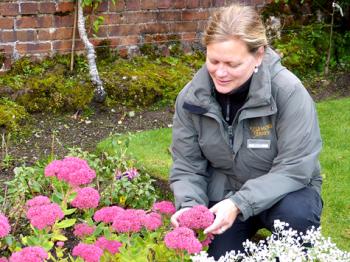Kylemore Abbey’s Victorian walled garden
This item appears on page 54 of the April 2018 issue.
The baronial-style castle, known today as Kylemore Abbey, was mirror-imaged in Lough Pollacappul this September 2017 day. Clouds scudding across Connemara’s gray-blue skies wound their way in and around the grand edifice’s shimmering reflection.
The castle’s setting against a wooded mountainside at the edge of the lake was breathtaking. Who could look at it and not wonder, ‘What’s it like inside?’
Regularly scheduled tours offer visitors the opportunity to traipse through several of the castle’s public rooms, a possibility that I’d placed in my “if time allows” mental folder before embarking on the hour-plus drive north from Galway City into the Connemara countryside. The reason? I wanted to spend as much time as possible in its 6-acre, 19th-century, walled garden.
The garden’s early years
Whatever the reason for making a trek to Kylemore — castle, garden or both — step back to the mid-1840s when Mitchell Henry and his wife, Margaret, honeymooned in Ireland, spending time at an idyllically situated hunting lodge in Kylemore.
Fast-forward 20 years, during which Mitchell, a skilled London surgeon, abandoned his medical career when he inherited his family’s Manchester textile manufacturing fortune. Declaring himself Irish through and through, he entered liberal politics. For 14 years, Mitchell represented County Galway as a member of parliament.
In the late 1860s, as a token of love for his wife and as a country home for their family of nine children, Mitchell purchased the Kylemore hunting lodge site and 13,000 surrounding acres.
In 1867, the castle’s foundation cornerstone was laid. Four years later, with over 100 workmen involved in the task, the castle was ready for occupancy — 70 rooms showcasing the latest in Victorian-era furnishings and technology.
At the same time, the walled garden was under construction — out of sight of the main house as was the tradition of the time — at Kylemore, a mile away.
There, too, innovations of the era were incorporated, among them a complex system of 5,000 feet of hot-water pipes, heating 21 glasshouses in which were grown such exotics as bananas, melons, nectarines, pineapples, wine grapes and tomatoes.
Beyond providing an elaborate country estate for his family, Mitchell Henry had another vision for Kylemore. With much of Ireland still staggering from the economic depression of the 1845-1852 Great Irish Famine, he saw the estate as an avenue of proactive and compassionate help for the people of Connemara.
The house and garden provided employment for an army of people. In addition, 125 tenant farmers worked the estate, with Henry providing shelter, good pay and a school for the children.
Tragedy struck in 1874. While the couple traveled in Egypt, Margaret fell fatally ill. Heartbroken, Mitchell Henry left Kylemore and returned to England. In 1903, he sold the estate.
But times were changing. The old landscape of over-the-top mansions, deference and cheap labor were on their way to no more. Kylemore’s castle, estate and garden gradually slid into decline.
A second chance
In 1920, a community of Benedictine nuns fleeing war-torn Belgium purchased Kylemore. The castle became their abbey, in which they opened a reincarnation of the girl’s international boarding school and day school they had left behind in Ypres. In 2010, the last student received her diploma. The school closed, with the nuns already involved in new educational and tourism endeavors.
“For a good time after their 1920 arrival, the nuns did their best to maintain the garden,” Anja Gohlke, into her 16th year as abbey head gardener, told me over a cup of tea in the garden’s tearoom. “And they did manage to always keep much of the vegetable garden going.”
Anja, who studied landscape architecture at an East Berlin technical college, came to the garden as a 3-month intern, returning later as assistant to the head gardener. When the head gardener left, she was offered the position.
“By the 1950s,” said Anja, continuing the garden’s narrative, “all had gone wild.”
Overgrowth smothered the plantings, cows wandered through, and of the 21 glasshouses, 20 had collapsed. Anja compared its plight to that of Cornwall’s Lost Gardens of Heligan (May ’13, pg. 58).
Reprieve came in 1994 with the Great Gardens of Ireland Restoration Programme, grant-aided by the European Regional Development Fund and targeted toward gardens of significance with the potential to sustain tourism. The Kylemore Abbey application was accepted.
Restoration, although painstakingly slow, was aided by a description of the garden that was included in Mitchell Henry’s 1903 sale of the property.
“Even so, it took two years just to uncover the original pathways!” Anja said.
“But there was no plant list,” she continued, “and everything — shrubs, perennials, bedding plants, fruit trees, varieties of vegetables — had to be true to Kylemore’s Victorian past.”
Nineteenth-century photos were found, a few bills of sale were located, and local folk memory was relied upon. In 1999, the garden opened to visitors.
What you’ll find
Anja accompanied me to the garden. As we walked through an upper gate, the entirety of the garden was revealed below in the shape of a wide V, its base puddled this day in off-and-on drizzle.
Anja pointed out the woodland and fern-bordered stream dividing the garden. Featured on one side, the pleasure garden, were colorful swaths and borders of perennials and annuals, and on the other, the production garden in which vegetables are grown.
Finding suitable historical material for both continues to send Anja on a never-ending treasure hunt through obscure seed catalogs and nurseries in a search for still-available Victorian-era varieties or today’s near equivalents.
Anja bid me good-bye, leaving me to explore the garden guided by descriptive signage placed throughout the 6 acres.
In the production garden, vegetables and herbs shared space with beds devoted to cut flowers destined for the house. Signage there let me know that cherry, plum and pear trees trained along the brick walls were placed to take advantage of the bricks’ heat-retaining ability, hastening ripening.
Two of the original 21 glasshouses were rebuilt. One, devoted to examples of the exotics enjoyed by the Mitchell family and their guests, is open to visitors. The other, where propagation of plant material takes place, allows only a tantalizing peek through the door.
Wisps of chimney smoke from matching tidy cottages on the far side of the garden beckoned — the head gardener’s cottage and the workmen’s “brothy” (a shelter for garden workers) — with interiors returned to Victorian days.
Close by, a brick shed displayed garden tools of the era. Next to it, another shed told the story of the garden’s restoration.
A shuttle would have carried me back to the garden tearoom. I chose to take the path, shuffling through early autumn-fallen leaves.
“Kylemore” originates from the old Irish words coill mor, one translation of which is “big wood.” In 1995, Kylemore Abbey undertook returning the estate to what it was once. Ten thousand indigenous oak and ash trees were planted, with more added each year in an ongoing program.
The day was fast departing. Alas, a visit to the abbey, itself, would have to remain in my “if time allows” mental file.
Planning a visit
Kylemore Abbey is open daily, except on certain dates. Opening and closing times vary seasonally; see www.kylemoreabbey.com for variations from the high-season hours of 9 a.m. to 7 p.m., July through late August.
An entry ticket costs €13, adult; €10, senior (64 and older), or €9, student. Kids age 10 and under enter free, and there are discounts for online bookings.
A ticket includes a visit to the restored abbey rooms, history talks, shuttle bus rides between the castle and the walled garden a mile away, miles of woodland and lakeshore walks, and a guide booklet and map.
For more information, contact the Kylemore Abbey Visitor Centre (Kylemore Abbey, Pollacappul, Connemara, Co. Galway, Ireland; phone +353 95 52001 or email bookings@kylemoreabbey.com).
Email Yvonne Michie Horn at yhorn@sonic.net. Also visit www.the travelinggardener.com.



